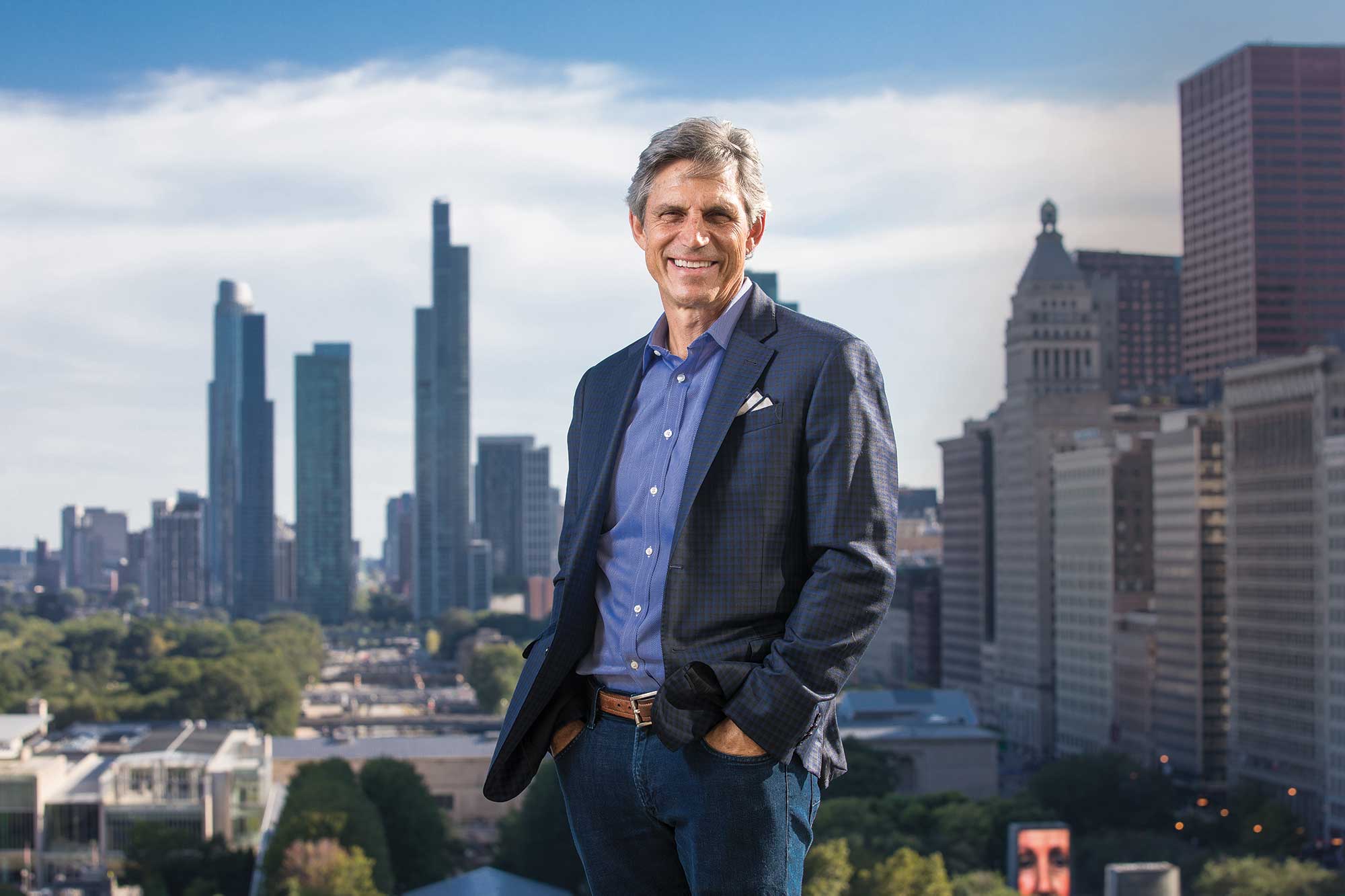
Meet the Quiet Giant of Chicago Real Estate Development
How Wanxiang America Real Estate Group is reshaping the city’s skyline, one deal at a time.
With lending still ice-cold in a post-recession 2011 and the Chicago developer grappling with loan issues at a landmark West Loop office building it had purchased just before the crash, Krueger, a real estate veteran handpicked to get auto parts manufacturer Wanxiang America into the commercial property game, swooped in to recapitalize the building and put it on solid financial footing. The next year, Sterling Bay sold the property at 300 W. Adams St. for more than twice what it paid in 2007.
“It worked out pretty well,” Krueger recalls of the deal, his first with then-small Sterling Bay. “And then they were off.”
The investments make Wanxiang one of the most prominent—and yet stealthiest—backers of major commercial development in Chicago at a time when many deep-pocketed investors have gone cold on the city, scared off by the uncertain future of property assessments and taxes that is clouding the prospects of downtown commercial real estate.
Chicago “is an extremely diverse market, and if our weather was better, we’d probably have 30 million people and you couldn’t afford to live here,” says Krueger, 63, a Winnetka resident who spent 19 years as an executive at Dallas-based real estate investment firm Prentiss Properties Trust until it was sold in 2006. “The growth has been great.”
Commercial real estate insiders and veterans who know Krueger best describe him as a whip-smart student of the industry with an eye for opportunity where others see risk. Most say his penchant for squeezing every penny possible out of a deal has served Wanxiang’s Chicago partners well—a list that serves as a veritable who’s who of commercial development with names like skyscraper builder Riverside Invesment & Development, Magellan Development Group of Vista Tower fame and CA Ventures, in addition to Sterling Bay.
Wanxiang’s recent default with hotelier Laurence Geller on the Waldorf Astoria Chicago hotel is the only noticeable local blemish on a nine-year track record that includes high-risk, high-reward towers and lucrative returns for the company and the developers it backs.
FINANCIAL BACKING
Krueger chalks up part of his firm’s hot streak to its combination of high-octane financial backing—Wanxiang America is the U.S. offshoot of China’s largest auto parts component manufacturer, though Krueger is quick to point out his firm only recycles domestic capital and doesn’t pull funds from China—and its ability to quickly pull the trigger on deals that might take months to pass muster with a deep-pocketed lender or pension fund.
“Time kills deals, and red tape can kill deals. Institutional investment committees can kill deals,” Krueger says. His team totals just five employees working out of a small office at 150 N. Riverside, a 54-story skyscraper Wanxiang helped finance for developer John O’Donnell. “Not every investment is perfect, obviously. And, frankly, in the early stages of 2012, 2013 and 2014, if you overanalyzed you missed a lot of potential opportunities.”
Wanxiang’s agility is one reason its capital is generally more expensive than borrowing from an institutional lender, investors say. The higher costs come with greater flexibility to its borrowers to make quicker financial pivots and take on more debt on a project than a behemoth bank might allow.
Big project developers also gravitate toward Krueger for his expertise in real estate fundamentals, says Chicago real estate veteran David Kahnweiler, former CEO in the Chicago office of real estate services company Colliers International, who worked alongside Krueger in the early 1980s at industrial park developer Bennett & Kahnweiler.
“Larry learned the business from the numbers side first,” Kahnweiler says. He recalls that Krueger insisted he take his Apple computer—”his tool of the trade,” Kahnweiler says—when he left the firm in 1984 to help oversee real estate for Chicago developer and restaurant mogul Larry Levy.
Sterling Bay Managing Partner Andy Gloor remembers struggling to find a partner in 2011 to help him buy a hulking cold-storage facility in the middle of Chicago’s meatpacking district and turn it into an office building.
“A long list of them said I was crazy and it’s never going to work and I’m going to end up living in my dad’s basement,” Gloor recalls of the 10-story warehouse at 1000 W. Fulton St. that some thought might collapse if decommissioned. Wanxiang backed the deal, and Google made it its Midwest headquarters, setting off the transformation of the now-trendy Fulton Market District.
“Larry understands the business as well as the (developers) he partners with, and I’m sure in some cases better,” Gloor says. “I think that command of the business allows him to take some risks and evaluate deals that I think most people would stay away from.”
Krueger admits it’s getting harder to find good deals in Chicago a decade into a growth cycle. Despite glowing metrics about demand for offices, apartments and hotels, many commercial properties it would back in the city today are “priced to perfection,” he says, leaving little room for error.
Like many out-of-town investors sitting on the sidelines, he’s also wary of how new Cook County Assessor Fritz Kaegi’s approach to property valuation will affect landlords’ bottom lines. “I don’t think it’s being well thought out, and I think it’s too abrupt relative to the past,” Krueger says of Kaegi’s approach, which will likely shift more of the local property tax burden onto commercial properties when the city of Chicago is reassessed in 2021.
That uncertainty is the most common explanation for a sharp drop this year in Chicago-area commercial property sales, which were down 40 percent year-over-year through the second quarter to about $6 billion, the lowest mark for that period since 2014, according to research firm Real Capital Analytics.

